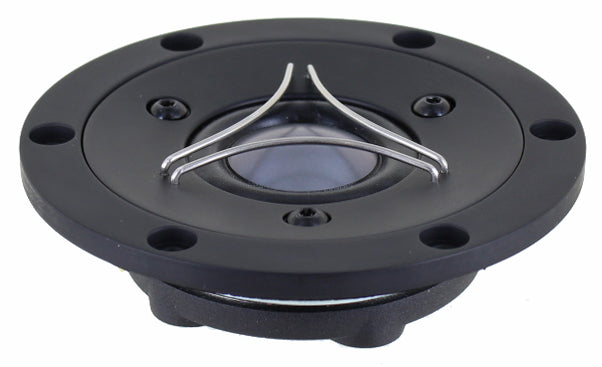In this blog post I look at the Satori TW29BN Beryllium Tweeter from SB Acoustics mounted to the 1159 Waveguide.
The 1159 waveguide uses my ES curvature in both the vertical and horizontal axis.

Frequency Response
We start by measuring the raw frequency response. 
Extending the graph out to 50kHz is shown below. We see that there is a mild breakup at 23kHz with a gentle roll-off out to 40kHz.
I added in a 3.3uF capacitor as shown below.
This results in the following response shown overlaid with the raw response.

I then added a 0.75mH inductor to create a 2nd order filter.

The resulting frequency response is shown below in red.

I could hear some faint hissing from the driver when I put my ear up to it so I decided to add a fixed resistor L-pad as shown below. This attenuated the driver by about 10dB. This is required for the IMD test shown later. This can be avoided by using an amplifier with less gain. The amplifier used in this test is the Hypex FA501 which has 500w output capability.

The below response shows the affect of the -10dB L-Pad circuit (light green).
Showing just the final response and limiting the graph to 20kHz is shown below. This represents an average target response for a 2-way loudspeaker using a 1.5kHz crossover point.
If we look at the off-axis performance I measured at 0,15,30, 45 degrees which is shown below. The 1159 waveguide is showing off here.
Burst Decay
Burst decay is shown below out to 20kHz. There is virtually nothing to report.

For interest's sake we can look at the result out to 50kHz. We see a well controlled mechanical breakup at 24kHz...quite impressive!

Cumulative Spectral Decay

Showing the same out to 50kHz is shown below.

Harmonic Distortion
Below I test harmonic distortion at 85dB at 1m. The tweeter breaks the .01% noise floor for H3 and H4.

Showing the same with the vertical scale changed from percent to decibels is shown below. H3 is -75dB at 3kHz.

Increasing the test signal to 95dB is shown below. We are almost touching the 0.001% noise floor for H3 and H4.

Showing the same with the vertical scale changed from percent to decibels is shown below. H3 and H4 are now -87dB for 3kHz.

Intermodulation Distortion
I begin by measuring the environmental noise in my studio to confirm adequate signal to noise ratios.

Testing IMD at 85dB is shown below. The tweeter maintains -74dB across most of it's bandwidth. There is a small spike in IMD at 18kHz.

Increasing the test SPL to 95dB is shown below. The tweeter maintains a -64dB across most of it's bandwidth.

Conclusion
The SATORI TW29BN Beryllium Tweeter is an excellent tweeter that exceeds my performance target for audiophile sound quality.




